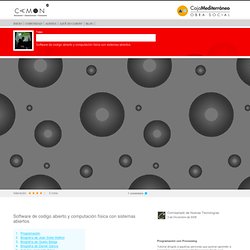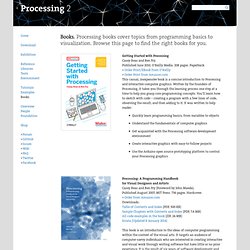

Tutorials \ Wiring. Fun Programming. Processing Lesson - YouTube. Tutorial de Processing para mentes Macromedia. Permítenos descomponer este código línea por línea. size(200,100); Nombrando la función de tamaño (size), permite el tamaño del lienzo a 200 píxeles de altura, 100 píxeles de ancho.

Si no defines esto al inicio quedará determinado como 100x100. background(0,0,0); Llamando la función de fondo (background) te permite cambiar el color de todo el lienzo. En Director esto es el color del escenario. Stroke(255,0,0); Llamar la función de trazo (stroke) te permite cambiar el color del dibujo actual de tal manera que cada comando de color llamado luego será dibujado usando ese color. 255,0,0 significa rojo.
Point(50,50); Llamar la función de punto (point) fijará el pixel en 50,50 al color del lienzo actual. Este código hace un punto verde en el centro. stroke(0,0,255); point(150,50); Este código dibuja el punto azul a la derecha. Como puedes ver, esto es similar a draw() en Lingo, o aquellos métodos de dibujo en ActionScript. Aquí hay unas formas prefabricadas. triangle(x1, y1, x2, y2, x3, y3); Luiscript » Software developer and trainer. Utilizando Arduino con un potenciómetro como fuente de datos en processing para general una señal de audio y una figura básica en pantalla.

PROCESSING ++ AFTER EFFECTS on Vimeo. Processing y Arduino - Tucamon.es. Processing y Arduino Software de codigo abierto y computación física con sistemas abiertos.

Processing se usa para crear desde los créditos de una película a la programación de robots, pasando por la creación de ambientes psicodélicos... En este taller aprendimos a cómo programar en uno de los lenguajes más de moda del momento. Programación Taller de cuatro horas, divididas en dos sesiones, para descubrir las posibilidades de la interacción entre código y sensores. Extended Language (API) \ Processing.org. Codes_librerias_las devvvvv -processing. 2016-03-15RT @bndktgrs: 幸せなコーディング!

Launched: Our #GenerativeDesign book has also a 🇯🇵 website now! 👍 [Link] Cheers @BugNews! @Proce… 2016-03-05RT @bndktgrs: Our #GenerativeDesign book made it to 🇯🇵 #Japan! [Link] published by BNN @BugNews #veryhapy [Link] 2015-10-08Updated! All code examples of Generative Design should be ready for #Processing3 now! Learning Processing: Tutorials: Libraries. Contributed Libraries This tutorial is an updated version of Section 12.3: Contributed Libraries.

Processing now allows for a “libraries” folder inside your Processing sketchbook, which is a great deal more convenient than having your 3rd party libraries installed in the Processing application folder. Now, when you upgrade to a new version of Processing you don’t have to copy your libraries over. As of the writing of this book, there are 47 contributed libraries, with capabilities ranging from sound generation and analysis, to packet sniffing, to physics simulations, to GUI controls. Several of these contributed libraries are demonstrated in this book’s examples. Where to install them First, locate where your Processing sketchbook. /Users/Username/Documents/Processing on a PC, it’s probably: c:/My Documents/Processing/ If it doesn’t already exist, create a folder called “libraries” here. Libros \ Processing.org. Processing: A Programming Handbook for Visual Designers and Artists Casey Reas and Ben Fry (Foreword by John Maeda).

Published August 2007, MIT Press. 736 pages. Hardcover. » Order from Amazon.com Downloads: Table of Contents and Index (PDF, 500 KB) Sample Chapters with Contents and Index (PDF, 7.6 MB) All code examples in the book (ZIP, 24 MB) Errata (Updated 8 January 2014) This book is an introduction to the ideas of computer programming within the context of the visual arts. It targets an audience of computer-savvy individuals who are interested in creating interactive and visual work through writing software but have little or no prior experience. The majority of the book is divided into tutorial units discussing specific elements of software and how they relate to the arts. Essays by Alexander R. If you are an educator, you can request a desk/exam copy from the MIT Press website.
Processing Tutorials – Plethora Project. Plethora-Project.com is an initiative to accelerate computational literacy in the frame of architecture and design.

It aligns with the "show me your screens" motto of the TopLap live-coding group attempting to get rid of Obscurantism in digital design. Directed by Jose Sanchez Contact me at : jomasan@gmail.com Bio: Jose Sanchez is an Architect / Programmer / Game Designer based in Los Angeles, California. He is partner at Bloom Games, start-up built upon the BLOOM project, winner of the WONDER SERIES hosted by the City of London for the London 2012 Olympics. He is the director of the Plethora Project (www.plethora-project.com), a research and learning project investing in the future of on-line open-source knowledge. Collections - OpenProcessing.